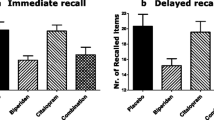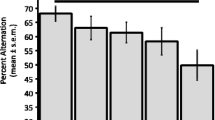Abstract
The effects on memory, psychomotor functions and mood of intramuscular scopolamine (0.3 mg, 0.6 mg) were compared with those of oral lorazepam (2 mg) and placebo. Thirty-six volunteers took part in a doubleblind, independent groups design. Subjects completed a battery of tests 1 and 3 h after drug administration. Both doses of scopolamine produced levels of sedation comparable to that produced by lorazepam. The time course of effects of scopolamine and lorazepam differed but the pattern of psychomotor impairments and amnestic effects produced was very similar. In terms of mood, lorazepam had an anxiolytic effect whereas scopolamine increased ratings of anxiety. Levels of sedation, indexed by either subjective ratings or motor retardation (tapping speed), were related more to psychomotor performance than to performance on memory tasks. The results suggest that benzodiazepines and scopolamine have similar amnestic and sedative effects and as such may not offer distinct models of memory dysfunction.
Similar content being viewed by others
References
Baddeley AD (1968) A 3 min reasoning test based on grammatical transformation. Psychosom Sci 10:341–342
Battig WF, Montague WE (1969) Category norms for verbal items in 56 categories: a replication and extension of the Connecticut Category norms. J Exp Psychol 80:1–46
Beatty WW, Butters N, Janowsky D (1986) Patterns of memory failure after scopolamine treatment: implications for cholinergic hypotheses of dementia. Behav Neural Biol 45:196–211
Bond AJ, Lader MH (1974) The use of analogue scales in rating subjective feelings. Br J Med Psychol 47:211–218
Broks P, Preston GC, Traub M, Poppleton P, Ward C, Stahl S (1988) Modelling dementia: effects of scopolamine on memory and attention. Neuropsychologia 26:685–700
Caine ED, Weingartner H, Ludlow CL, Cudahy EA, Wehry S (1981) Qualitative analysis of scopolamine-induced amnesia. Psychopharmacology 74:74–80
Callaway E (1984) Human information processing: some effects of methylphenidate, age and scopolamine. Biol Psychiatry 19:649–662
Collerton D (1986) Cholinergic function and intellectual decline in Alzheimer's disease. Neuroscience 19:1–28
Curran HV (1986) Tranquillising memories: a review of the effects of benzodiazepines on human memory. Biol Psychol 23:179–213
Curran HV, Schiwy W, Lader M (1987) Differential amnesic properties of benzodiazepines: a dose response comparison of two drugs with similar elimination half-lives. Psychopharmacology 92:358–364
Curran HV, Schiwy W, Eves F, Shine P, Lader M (1988) A levels of processing' study of the effects of benzodiazepines on human memory. Hum Psychopharmacol 3:21–25
Drachman DA (1978) Central cholinergic system and memory. In: Lipton MA et al. (eds) Psychopharmacology: a generation of progress. Raven Press, New York
Dunne MP, Hartley LR (1985) The effects of scopolamine upon verbal memory: evidence for an attentional hypothesis. Acta Psychol 58:205–217
Eysenck MW (1982) Attention and arousal: cognition and performance. Springer, Berlin
File SE, Lister RG (1983) Does tolerance to lorazepam develop with once weekly dosing? Br J Clin Pharmacol 16:645–650
Frith CD, Richardson JTE, Samuel M, Crow TJ, McKenna PJ (1984) The effects of intravenous diazepam and hyoscine upon human memory. Q J Exp Psychol 36A:133–144
Ghoneim MM, Mewaldt SP (1975) Effects of diazepam and scopolamine on storage, retrieval and organisational processes in memory. Psychopharmacologia 44:257–262
Ghoneim MM, Mewaldt SP (1977) Studies on human memory: the interactions of diazepam, scopolamine and physostigmine. Psychopharmacology 52:1–6
Jones DM, Jones MEL, Lewis MJ, Spriggs TLB, (1979) Drugs and memory: effects of low doses of nitrazepam and hyoscine on retention. Br J Clin Pharmacol 7:479–483
Kopelman MD, Corn TH (1988) Cholinergic ‘blockade’ as a model for cholinergic depletion. Brain 111:1079–1110
Lacey JI (1967) Somatic response patterning and stress: some revisions of activation theory. In: Appley MH, Trumbull R (eds) Psychological stress. Appleton-Century-Crofts, New York
Mayes AR, Pickering A, Fairburns A (1987) Amnesic sensitivity to proactive interference: its relationship to priming and the causes of amnesia. Neuropsychologia 25:211–220
Nuotto E (1983) Psychomotor, physiological and cognitive effects of scopolamine and ephedrine in healthy man, Eur J Clin Pharmacol 24:603–609
Peck RE (1959) The SHP-test—an aid in the detection and measurement of depression. Arch Gen Psychiatry 1:35–40
Preston G, Ward C, Lines C, Poppleton P, Haigh J, Traub M (1989) Scopolamine and benzodiazepine models of dementia: cross-reversals by RO-15-1788 and physostigmine. Psychopharmacology 98:487–494
Richardson JTE, Frith CD, Scott E, Crow T, Cunningham-Owens D (1984) The effects of intravenous diazepam and hyoscine upon recognition memory. Behav Brain Res 14:193–199
Rusted JM (1988) Dissociative effects of scopolamine on working memory in healthy young volunteers. Psychopharmacology 96:487–492
Rusted JM, Warburton DM (1988) Effects of scopolamine on working memory in healthy young volunteers. Psychopharmacology 96:145–152
Sahakian BJ (1987) Cholinergic drugs and human cognition. In: Iverson LL, Iverson SD, Snyder SH (eds) Handbook of Psychopharmacology, vol 20. Plenum Press, New York
Shepherd RN, Metzler J (1971) Mental rotation of three-dimensional objects. Science 171:701–703
Spielberger CD, Gorsuch RL, Lushene RE (1969) The state-trait anxiety inventory. Consulting Psychologists Press, Palo Alto, California
Sunderland T, Tariot PN, Cohen RM, Weingartner H, Mueller EA, Murphy DL (1987) Anticholinergic sensitivity in patients with dementia of the Alzheimer type and age-matched controls: a dose response study. Arch Gen Psychiatry 44:418–426
Wechsler D (1955) Manual for the Wechsler adult intelligence scale. Psychological Corporation, New York
Weingartner H (1985) Models of memory dysfunctions. Ann NY Acad Sci 444:359–369
Wilson B, Cockburn J, Baddeley A (1985) The Rivermead behavioural memory test. Thames Valley Test Company, Reading
Author information
Authors and Affiliations
Rights and permissions
About this article
Cite this article
Valerie Curran, H., Schifano, F. & Lader, M. Models of memory dysfunction? A comparison of the effects of scopolamine and lorazepam on memory, psychomotor performance and mood. Psychopharmacology 103, 83–90 (1991). https://doi.org/10.1007/BF02244079
Received:
Revised:
Issue Date:
DOI: https://doi.org/10.1007/BF02244079




